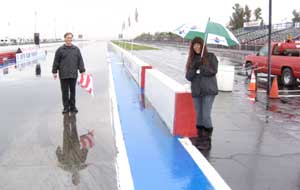
When It Rains, It Blows
4/7/06

hat the TV weatherpersons out here like to call “rain events” reminded me of the rain delays, rain postponements and outright rainouts that affected us year-’round track workers in the Sixties and Seventies. Making two solo trips to Bakersfield for the canceled March Meet recently provided 1100 miles’ worth of opportunities to indulge reflections of my wet-weather experiences between 1961 and 1975.
 Yeah, we could create some lame caption about former-Goodguys-champ Dave Gruzen checking out the track at Famoso, blah, blah, blah, but let's be real here: This photo appears because his wife, Rose, is such a babe! (HotRodNostalgia.com Photo By Dave Wallace, ©2006) |
Like many of you old farts squinting at this screen through bifocals, your columnist averaged about 1.5 events a week over all those years (even taking into account the 14 months and seven days wasted in Southeast Asia). Unlike most of you, I was working while you were playing on those hundreds of nights and days at San Fernando, Long Beach and Orange County. Thus would I find myself in the same room with a frazzled track operator on many a drizzly day, listening sympathetically while he’d argue with himself about what move to make next.
Consider: Ten thousand frozen hot dogs are thawing. Fans are huddling under umbrellas and bleachers. Track and concession workers await the word. Commercials have been airing for 10 days all across the ultra-expensive Los Angeles market. Souvenir T-shirts are stacked to the plywood ceiling of the goodie booth. The pits are packed with guaranteed Funny Car stars accustomed to getting half their fees for rainouts. Someone just said that Jim Dunn and Ed McCulloch are tired of waiting, and heading for the tower. The radio and TV stations have threatened to cut us off first thing Monday morning unless someone shows up with tens of thousands of dollars (like we promised the gorilla in the fancy suit who paid a surprise visit last week).
Harry Hibler (San Fernando), C.J. Hart (Lions, OCIR) and Jim Tice (OCIR and other AHRA tracks) repeatedly amazed me with their ability to rapidly adapt to unforeseen circumstances. If we lost power (possibly as a result of unpaid utility bills!), remaining contestants would be launched and judged by two humans waving flags, stationed 1320 feet apart. If it started sprinkling, spectators were invited to drive out onto the drag strip and park their street cars, bumper to bumper, to keep the surface dry. (Announcers never had to ask twice.) When it stopped raining, these folks were asked to make slow laps to burn off the moisture. If the top end was “weeping,” we’d shorten the course to an eighth-mile. No clocks? No time for qualifying? No problem; our “tower girls” would draw straws for positions, then expand the ladder to accommodate all-run fields. Should the sun set on a facility without lighting, fans would point their headlights towards the racing surface, then leave their engines running right through the final round.
No matter how dismal the weather forecast or race-day conditions, this trio’s common mantra could’ve been: “Get it in!” Hibler, Hart and Tice all accepted the reality that rain dates are always losers, financially. Besides, next weekend might well be worse.